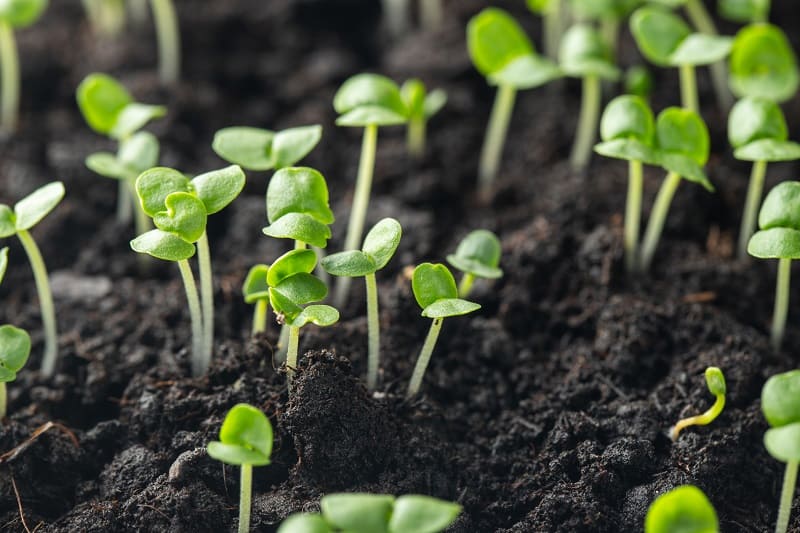
If your seedlings are turning yellow – a condition called chlorosis – the most common causes are root damage from wet soil, overwatering, or nitrogen deficiency.
Other causes of yellowing in seedlings are disease, pests, lack of nutrients, soil pH and other soil problems.
In this article, we will discuss the causes of yellowing seedlings and how to remedy each one.
Why are my seedlings turning yellow?
When a plant or a seedling turns yellow abnormally, it is called chlorosis. Chlorosis is a symptom of a lack of chlorophyll, which is the pigment that plants use to absorb and use sunlight so that they can turn water and air into food.
Chlorosis is caused by a number of factors including pests, disease, lack of nutrients, soil pH, compacted or damaged roots, and overwatering.
Seedlings lacking nutrients
When the soil that the seedlings are planted in has a pH either too high or too low, this can prevent the nutrients required by the plants from being available to them.
One of the most common deficiencies in plants is nitrogen deficiency. When seedlings do not get enough nitrogen, they can turn yellow. If your soil has sufficient nitrogen but your soil pH is too low, the nitrogen will not be available for the seedlings to use.
Chlorosis can also describe a deficiency of iron, manganese or zinc.
Seedlings have iron deficiency if their young leaves are turning yellow and the older leaves are also starting to turn yellow.
Nitrogen, manganese and zinc deficiency manifest as yellowing inner leaves, spreading to the outer leaves.
To find out the specific cause, you can ask a professional to perform a soil test.
Overwatering
Another reason seedlings turn yellow is too much water. When a seedling is overwatered, its roots become damaged and can no longer effectively perform their function of taking in nutrients from the soil. Plant roots can die when they drown in soggy soil, because they no longer have access to oxygen. This will result in the seedling turning yellow.
The best way to avoid overwatering is to check the soil. If it is dry you can water it, but if it is still damp wait one or two days before checking the soil again.
Stunted growth
Some seedlings can turn yellow and stop growing, leaving you wondering what happened. One of the causes of stunted growth in seedlings is nitrogen deficiency. It can also be caused by disease or pests, and even some environmental factors such as compacted soil, seeds planted too close to the surface, wet soil, and extreme soil temperatures.
When the temperature of the soil is too cold or too hot, the seedlings will have a hard time growing. Seeds prefer a temperature between 65 and 75 degrees Fahrenheit in order to germinate faster. Remember that even if the air is hot, the soil can still be cold.
If you are growing your seedlings in a seed tray, consider using a seedling heat mat so the seedlings get the warmth they need when temperatures are cold.
Make sure you do not overwater your seedlings, because that can also lower the soil temperature.
If you planted the seed too deep, it will have a more difficult time germinating because it cannot reach the surface and the light also cannot reach the seeds that badly need it. Conversely, if you plant the seeds too close to the surface, they may dry out and not germinate. You can usually read on the seed packet what depth the seeds prefer. If the packet does not come with instructions, a good rule of thumb is to simply plant the seed under a quarter inch of soil.
Long stems and small leaves
Seedlings will need plenty of light in the first few weeks of their life. If you are growing the seedlings indoors under a grow light, you may notice that they tend to stretch and grow in the direction of the light.
It is best to keep the grow light only about four inches away from the seedlings and raise the light as the seedlings grow taller. If you are using high-intensity lights, you can keep the light 18 inches away from the top of the plants. If you keep the light closer than necessary, it may end up burning the seedlings.
Bottom leaves turning yellow
When a seedling’s bottom leaves turn yellow, it could be due to several factors. These include a lack of nutrients, pests, disease and other environmental factors, but the most common cause of yellowing bottom leaves on a seedling is nitrogen deficiency. The next most common cause is soil that is perpetually wet and soggy.
Cotyledons
It is possible that the leaves you see that have turned yellow are the cotyledons. Cotyledons are the first leaves to emerge from the seed, but they are not considered true leaves. Their purpose is to give the seedling a good start, but when the seedling starts growing its own leaves, the cotyledons are no longer needed. This is when the cotyledons will turn yellow and fall off. If no other leaves are turning yellow except the cotyledon, your plants are probably completely healthy.
Conclusion
Seedlings can turn yellow due to different causes, ranging from something as benign and normal as cotyledons falling off of a growing plant, to factors that may need to be addressed and resolved.
Such factors include disease, pests, lack of nutrients, soil pH, soil problems and damaged roots.
If you think the yellowing of your seedlings is due to a negative cause, identify what it is as soon as possible so you can correct it immediately and save your seedlings.
Image: istockphoto.com / vasiliybudarin